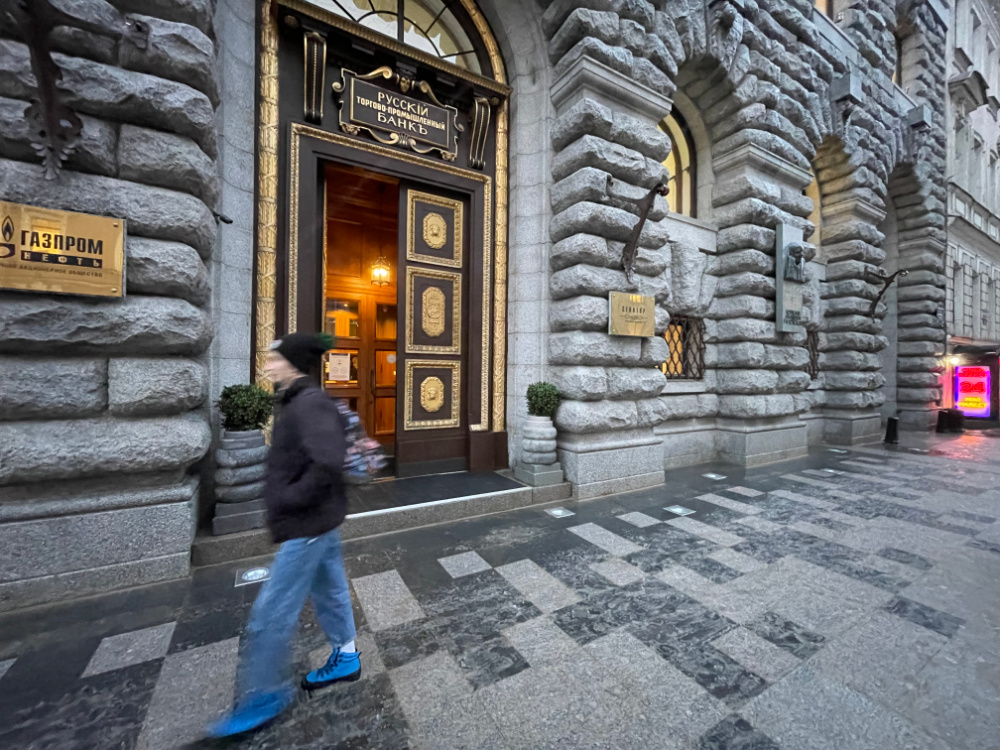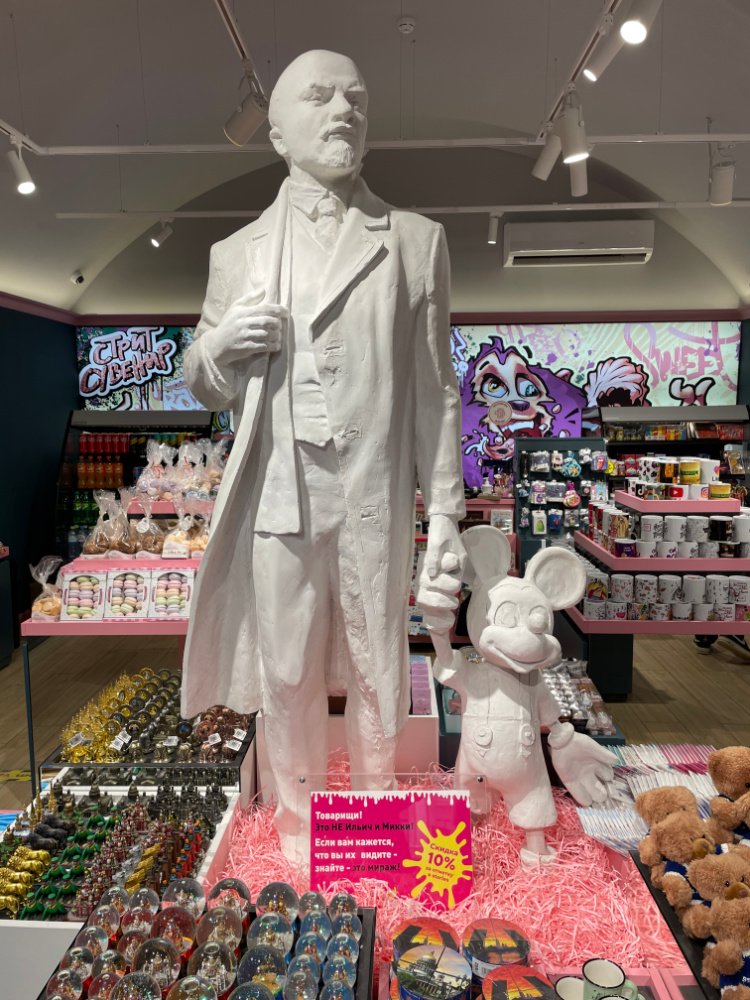ST. PETERSBURG, Russia—A couple of blocks from Gazprom, the state-owned Russian gas monopoly, the wooden floor of a museum creaks as women, masked against the pandemic, view photographs of guns, blood and the oppression of the strong against the weak.
The work is not a candid assessment of the Russian Federation’s havoc in Crimea or its troop buildup on the borders of Ukraine. Rather, it is the work of the South African photographer Juhan Kuus, who sought to document the brutality of apartheid between 1986 and 1999.
Russia on the eve of a possible war with Ukraine—the U.S. government says more troops are being added to the more than 100,000 already amassed on its borders—is not short on irony, intended or otherwise.
Even as Moscow continues to order troops to its borders with Ukraine, attrition is also at play in the Russian Federation’s natural gas capital to the north, St. Petersburg.
In January, natural gas shipments to Ukraine had fallen by about 57% compared to January 2021, according to data reported by Gazprom. Natural gas shipments to Europe have fallen 38% during the same time frame.
Gazprom, which is publicly traded, noted that working gas inventories in Europe’s underground storage facilities are down 22.3% compared to last year.
“As much as 93.4% of the gas injected during the summer period is already withdrawn, which means that less than 7%” remains, the company said on Feb. 16.

IHS Markit Vice Chairman Daniel Yergin, writing in the Wall Street Journal, said Russian exports have dropped substantially because of pricing, allowing U.S. LNG to fill in the gaps at prices about four times higher than normal.
“While the Ukraine crisis was raising anxiety about Europe’s dependence on Russian natural gas, something remarkable happened,” Yergin wrote. “Last month, for the first time ever, U.S. exports of liquefied natural gas to Europe exceeded Russia’s pipeline deliveries. Russian exports, which normally account for about 30% of Europe’s gas use, dropped substantially because of Russian pricing.”
Yet St. Petersburg, at the center of Russia’s stranglehold on European natural gas, seems to live inside a bubble of cold contradictions and a deliberate, intense apathy.
It is home to ultra-wealthy Gazprom. But a magnanimous tip at a city restaurant is perhaps 100 rubles—the equivalent of about $1.25. A 45-minute taxi ride, including tolls, costs about $8.
Tourists can explore the home of the Russian poet Anna Akhmatova, persecuted by Stalinist authorities. Or they are just as likely to browse nearby souvenir shops for busts of her tormentor, Joseph Stalin.
It’s as if any distinction between heroes or villains is irrelevant. Each day, fresh snow covers the sidewalks and lays fresh white togas on the statues of writers and warriors alike.
St. Petersburg is fraught this winter, naturally—just not by rumors of war. Rather, the simple drudgery of surviving the sidewalks takes precedence. For most of January and early February, the city, 500 miles below the arctic circle, is glazed with coatings of relentless ice.
A daily troop of workers resembling spelunkers, outfitted in helmets and harnesses, journey atop rooftops across the city and shovel heavy ice and snow onto the streets below.
Sidewalk show
On the ground, some pedestrians resemble cross-country skiers, using ski sticks to navigate the treacherous sidewalks. Life is lived on the sidewalk level. Many restaurants are set at basement elevation with windows opening onto foot traffic. This offers a live show for diners to watch as the hapless slide by.
If war could have a profound effect on everyday Russians, it is not openly discussed. At a watering hole called the Time Bar, a man, who said he was refused a U.S. Green Card, would rather talk European football than discuss the prospects of war, which he assiduously side steps.
A teacher, asked about Ukraine, said she doesn’t know anything about politics.

In the event of a Ukraine invasion, sanctions promised by President Joe Biden and NATO leaders could add to Russia’s woes. The country is already beset by low incomes and rising inflation. More targeted sanctions against Russia’s oligarchs are, analysts have said, likely to have the same negligible effect as those levied in 2014 following Russia’s annexation of Crimea.
Many have speculated on Russia’s potential to retaliate by withholding natural gas supplies from Europe. Gazprom, which has said it is meeting its contractual obligations with Europe, supplies roughly 30% of Europe’s natural gas.
And despite the LNG cargoes, it still exported nearly 6,218 million cubic meters of gas to Europe in January.
Rystad said on Feb. 15 that hostilities could put up to 155 billion cubic meters of European natural gas imports at risk. The world of oil and gas is often burdened by overreaction. How Russia, Europe and natural gas eventually plays out is just game theory for now.
And the drumbeats of war that seem so distinct to Western ears are apparently muted in St. Petersburg. Some sympathetic U.S. commentators have likened Russia’s posture toward Ukraine as reasonable, comparing it to a hypothetical U.S. response to an invasion of Mexico by China.
In the U.S., surely a sudden surge of Chinese soldiers south of the border would drive public discourse. In St. Petersburg, no mass gatherings formed, either in support of peace or to press for war. Pamphlets shoved into the hands of passersby don’t advertise rallies but the typical tours (there’s more than one torture museum in the city) or places to drink.
Everyday Russians have perhaps more important things to worry about. The nation’s population is steadily aging. A remarkably overeducated population is stagnating. In 2018, more than 63% of 25- to 34-year-olds in the Russian Federation had earned a secondary education, compared to an average 44% in other economically advanced countries, according to the OECD. Yet in 2020, the average salary in Russia rose to 32,422 rubles—about $450 annually, according to government statistics.
And like the rest of the world, Russia remains at the mercy of the pandemic.
New rules recently went into effect across the world’s largest country requiring proof of vaccination to enter restaurants or cultural sites.
Such measures were seemingly taken in stride. One early Monday morning, a woman in a navy jacket was stopped by a sentry at the entryway of McDonald’s.
Without complaint, she produced her smartphone. A McDonald’s employee scanned a QR code before she was allowed to order her breakfast sandwich and hashbrowns via a large digital touchscreen. (The country still retains some of its Soviet doublespeak, as needed. The country eschews lockdowns in favor of “worker’s holidays.”)
Gas and violence
At the Adamson-Eric Museum near one of Gazprom’s offices, a portrait of Kuus himself is hung near the entrance to the exhibition. Kuus is a skinny man beneath a broad-brimmed hat, a bandage leaking blood under his right eye. A pair of cameras are slung across his chest like bandolier belts.
The exhibition is presented without commentary, except through what Kuus told interviewers years before. Kuus, who died in 2015, said his photography focused on the explicit violence he witnessed “because I detested, and still do, all forms of violence.”
Russians may also be quiet because its rules for peaceable assembly and free speech are vastly different than those in Western democracies. That’s in contrast to protests for the Russian opposition leader Alexei Navalny, which the BBC reported last year had resulted in thousands of people participating in protests.

St. Petersburg is also a military town. The massive Admiralty building, home of the Russian navy, includes metal signs proclaiming the airspace a “no fly zone” written in Russian and English, with images of drones slashed out in red for emphasis. Military police are noticeably present at cultural sites.
Perhaps the fate of Ukraine is too remote to ponder in a city 750 miles to the north. In the winter, most Russians seemed focused only on the path ahead and that next slippery patch to avoid.
Or perhaps the inhabitants of a 320-year-old city, which endured a Nazi siege during World War simply see things differently.
Tucked into an alley beside a pizza shop, a stone tablet commemorates the siege by celebrating the city’s beauticians who continued to work even as the city endured starvation. (With jokey shops such as Coffee Therapy and a Museum of Soviet Arcade Machines, it’s sometimes difficult to know what to take seriously.)
At the end of the siege of Stalingrad, the plaque proclaims in etched Russian letters, beauty prevailed.
The present conflict, if one materializes, may well hinge on the power of the invisible—LNG exports—to keep Europe out of darkness.
Recommended Reading
Crescent Energy Closes $905MM Acquisition in Central Eagle Ford
2025-01-31 - Crescent Energy’s cash-and-stock acquisition of Carnelian Energy Capital Management-backed Ridgemar Energy includes potential contingency payments of up to $170 million through 2027.
Petro-Victory Buys Oil Fields in Brazil’s Potiguar Basin
2025-02-10 - Petro-Victory Energy is growing its footprint in Brazil’s onshore Potiguar Basin with 13 new blocks, the company said Feb. 10.
Apollo Funds Acquires NatGas Treatment Provider Bold Production Services
2025-02-12 - Funds managed by Apollo Global Management Inc. have acquired a majority interest in Bold Production Services LLC, a provider of natural gas treatment solutions.
Report: Diamondback in Talks to Buy Double Eagle IV for ~$5B
2025-02-14 - Diamondback Energy is reportedly in talks to potentially buy fellow Permian producer Double Eagle IV. A deal could be valued at over $5 billion.
VAALCO Acquires 70% Interest in Offshore Côte D’Ivoire Block
2025-03-03 - Vaalco Energy announced a farm-in of CI-705 Block offshore West Africa, which it will operate under the terms of an acquisition agreement.
Comments
Add new comment
This conversation is moderated according to Hart Energy community rules. Please read the rules before joining the discussion. If you’re experiencing any technical problems, please contact our customer care team.






